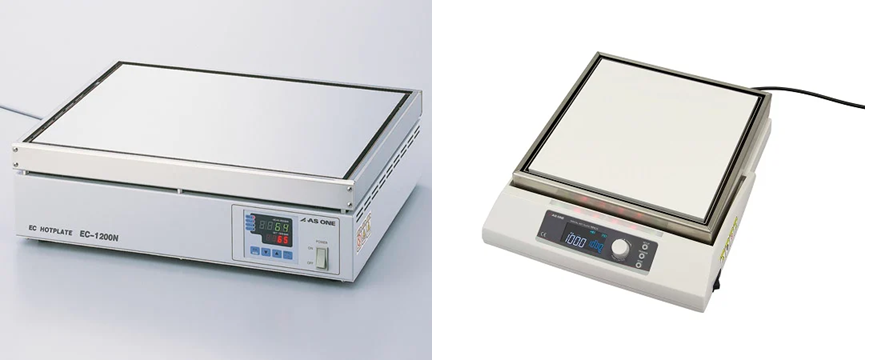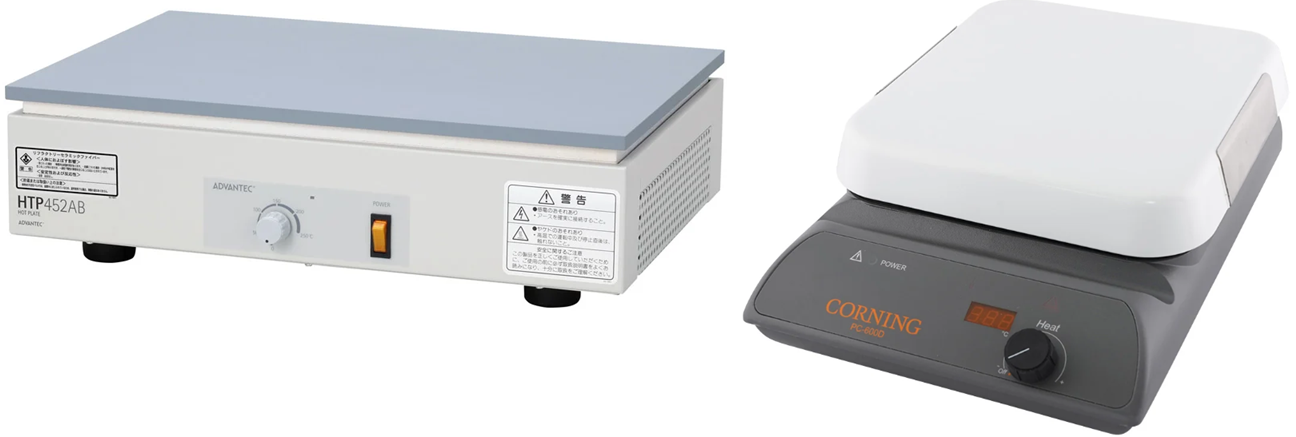
1/ Introduction to Laboratory Hot Plates
Laboratory hot plates are specialized devices used to heat samples, solutions, and materials in a controlled environment without an open flame. By maintaining stable and uniform temperatures, they reduce fire and explosion risks while ensuring researcher safety.
These hot plates support a wide range of chemical reactions, quantitative analyses, and sample drying processes. Precise temperature control also enhances reproducibility of experimental results.
2/ Operating Principle
Laboratory hot plates convert electrical energy into heat through a heating coil embedded beneath the plate surface. The heat output
where U is the applied voltage and I is the current.
An integrated PID (proportional-integral-derivative) controller continuously measures the temperature via a sensor and adjusts power input to minimize the difference between setpoint and actual temperature.
3/ Construction and Main Components
- Heating surface: typically aluminum with a ceramic or porcelain coating for chemical resistance and scratch protection.
- Heating element: high temperature resistance coil under the plate.
- PID controller: digital display, buttons or knobs for setting temperature and time.
- Temperature sensor: usually a K-type thermocouple for accurate readings.
- Insulation and housing: minimize heat loss and shield users from hot surfaces.
- Over-temperature protection: automatic shut-off when safe thresholds are exceeded.
4/ Practical Applications of Laboratory Hot Plates
Laboratory hot plates serve as the starting point for most analytical, synthetic, and sample-preparation workflows across diverse scientific fields.
4.1/ Chemical Synthesis
- Conducting reflux, distillation, and fractional distillation of organic compounds.
- Concentrating reaction mixtures by solvent evaporation.
- Heating under vacuum or inert gas when paired with round-bottom flasks.
4.2/ Sample Preparation and Processing
- Kjeldahl digestion for nitrogen content analysis in food, soil, and fertilizers.
- Pre-treating arsenic, mercury, and other samples for atomic absorption spectroscopy.
- Drying solid samples to below specified moisture levels before accurate weighing.
4.3/ Biotechnology and Biomedicine
- Melting and pouring agar for microbial culture media at 37 - 45°C.
- Incubating enzyme or antibody solutions for ELISA assays without denaturing biomolecules.
- Assisting in cell lysis protocols with consistent heating, especially when combined with stirring.
4.4/ Physical Properties Measurement
- Determining oil viscosity with Saybolt or Brookfield viscometers at 40°C and 100°C.
- Measuring melting points and softening points of polymers, waxes, and thermoplastics.
- Pre-heating samples for thermogravimetric analysis (TGA) and differential scanning calorimetry (DSC).
4.5/ Materials and Polymer Research
- Pre-heating polymer samples before molding or fiber-spinning to ensure homogeneous temperature distribution.
- Rapid curing of resins through programmed, multi-stage heating to enhance mechanical properties.
- Pre-drying adhesives or coatings to speed up sample preparation in new material evaluations.
4.6/ Education and Training
- Demonstrating exothermic and endothermic reaction profiles and PID control principles.
- Developing user skills in equipment handling, electrical safety, and fire hazard prevention.
- Simple teaching experiments: boiling water and observing phase changes.

5/ Guide to Selecting a Laboratory Hot Plate
To choose the right hot plate, clarify your application requirements and technical constraints. The following steps will guide your decision:
5.1/ Determine Usage Requirements
- What are the sample dimensions and mass?
- What maximum temperature is needed?
- Is magnetic stirring required?
- How frequently will the device be used, and what is the working environment (corrosive chemicals, cleanroom, etc.)?
Clarifying these factors narrows down your options from the start.
5.2/ Evaluate Technical Specifications
Compare key specifications of candidate models:
- Power rating: 350 - 2000W influences heating rate.
- Plate dimensions: 120 x 120 mm to 600 x 400 mm ensures sufficient workspace.
- Temperature range: typically 50 - 400°C, with accuracy of +/-1°C and uniformity of +/-3°C.
- Control system: mechanical knobs or digital PID with multi-stage programming and timers.
- Additional features: over-temperature alarms, standby modes, integrated stirring, IoT connectivity.
5.3/ Detailed Selection Criteria
- Heating surface material
+ Ceramic-coated porcelain: easy to clean, chemical-resistant.
+ Ceramic-coated aluminum: faster heat transfer, lightweight.
- Safety features
+ Over-temperature cutoff and automatic shutdown.
+ Insulated housing and electrical protection.
- Usability
+ Clear digital display, responsive controls.
+ Easy replacement of thermocouple sensors.
- Brand reputation and service
+ Popular manufacturers: AS ONE, IKA, Advantec, Corning,…
+ Minimum 12-month warranty.
- Budget considerations
6/ Operation, Maintenance, and Safety
Before switching on, ensure the plate surface is clean and dry, and remove any flammable materials. After use, let the hot plate cool fully before wiping the ceramic with a soft cloth. Calibrate the temperature sensor periodically to maintain accuracy. Inspect power cords, over-temperature cut-offs, and insulation annually to extend equipment life.
Where to Find Laboratory Hot Plates?
You can find genuine laboratory heating plates from many professional suppliers such as QTE Technologies.
QTE Technologies is a proud global MRO supplier, serving customers in over 180 countries and always striving to ensure customers have a complete and satisfied experience. Established in 2010, we provide over 1 million products for every industry and science and technology. In addition, you can contact us anytime via 24×7 chat support, phone, WhatsApp or email. Discover what our valued customers have to say about our services on our dedicated review page.
Author: Editorial team of QTE Technologies (with a strong background in both engineering and innovation - accumulated over 15 years of experience).




